
Published on: 04 Aug 2022 , 8 mins to read

Training module template: The first step to online course development
You’ve got the perfect idea for how to skyrocket your business goals. Your employees will need to learn some new skills, and then apply new techniques on the job. All you need to do is design that course.
But what’s the best way to build training that doesn’t overwhelm people with too much content? You don’t want to create a “training firehose” that leaves them dazed.
Organizing your courses into training modules creates a structure . And this structure helps deliver successful L&D programs. It might be tempting to curate online material or find a premade course and share that with your learners. It’s definitely fast.
But fast isn’t always effective.
A training module will help you choose the right content for the right purpose , decide on the best content type, and tie all your material together to achieve a larger learning outcome.
In this article, we’ll discuss the value of modules and how to create a training module that fits your company’s training goals. If you want to skip the guide, you can scroll down, download our free and customizable template , and start creating your training module right away.
What is a training module?
Let’s start with a definition: A training module is a section of your eLearning course that focuses on one topic . It’s an individual piece of the overall concept.
Think of modules like chapters in a book. For instance, say you’re creating a course on customer service. You might have separate modules to teach handling complaints, solving problems, and building customer relationships.
Each lesson in the course may be a module, but it’s also possible to have several lessons within one module. For instance, if one of your customer service modules focuses on problem-solving, you might include lessons on understanding customers’ perspectives, communicating effectively, and managing expectations within the module.
5 steps for how to create a training module
When you’re building training modules, you want to ensure they’re engaging and that they serve all your learners equally. Here’s a step-by-step guide on how to create quality training modules.
Step 1: Identify your learning objectives
As with any important task, you must start with clear goals. What is it you want to achieve with your training? The right target will help you understand what content to include and what tools to use.
Start by looking at problems your teams face. What are you trying to solve with the training? Once you know what you want to achieve, you can begin to break your bigger goal down into individual topics that will be the foundations of your modules.
For instance, say you have a company goal of improving customer satisfaction scores by 15% by the end of the year. You determine that to achieve your goal, employees need to be trained in how to have effective problem-solving conversations with customers.
Next, select specific learning objectives for each module. Focus on making them SMART—set specific, measurable targets that are relevant to the bigger goal.
Your training objective for the problem-solving conversations module might include understanding how to begin a conversation confidently, proper communication etiquette, dealing with difficult situations, and following up with a customer.
Step 2: Decide on your content type(s):
Once you know your learning objectives, decide what content formats will best serve them. Different content types work for different skill sets and audiences. Some of the content types you might consider include:
- Video. This format is great for illustrating skills in action, explaining hard-to-grasp concepts, and getting people’s attention.
- Scenario-based learning. Here you present learners with scenarios they might face on the job, so they learn the skills in context. Use these training modules for employees who need a chance to practice in a safe environment and get comfortable using the skills on the fly.
- Quizzes. Quizzes test learners on the knowledge they’ve gained. They’re a great way to boost engagement with gamification and make things more fun. They’ll also help you track learners’ understanding.
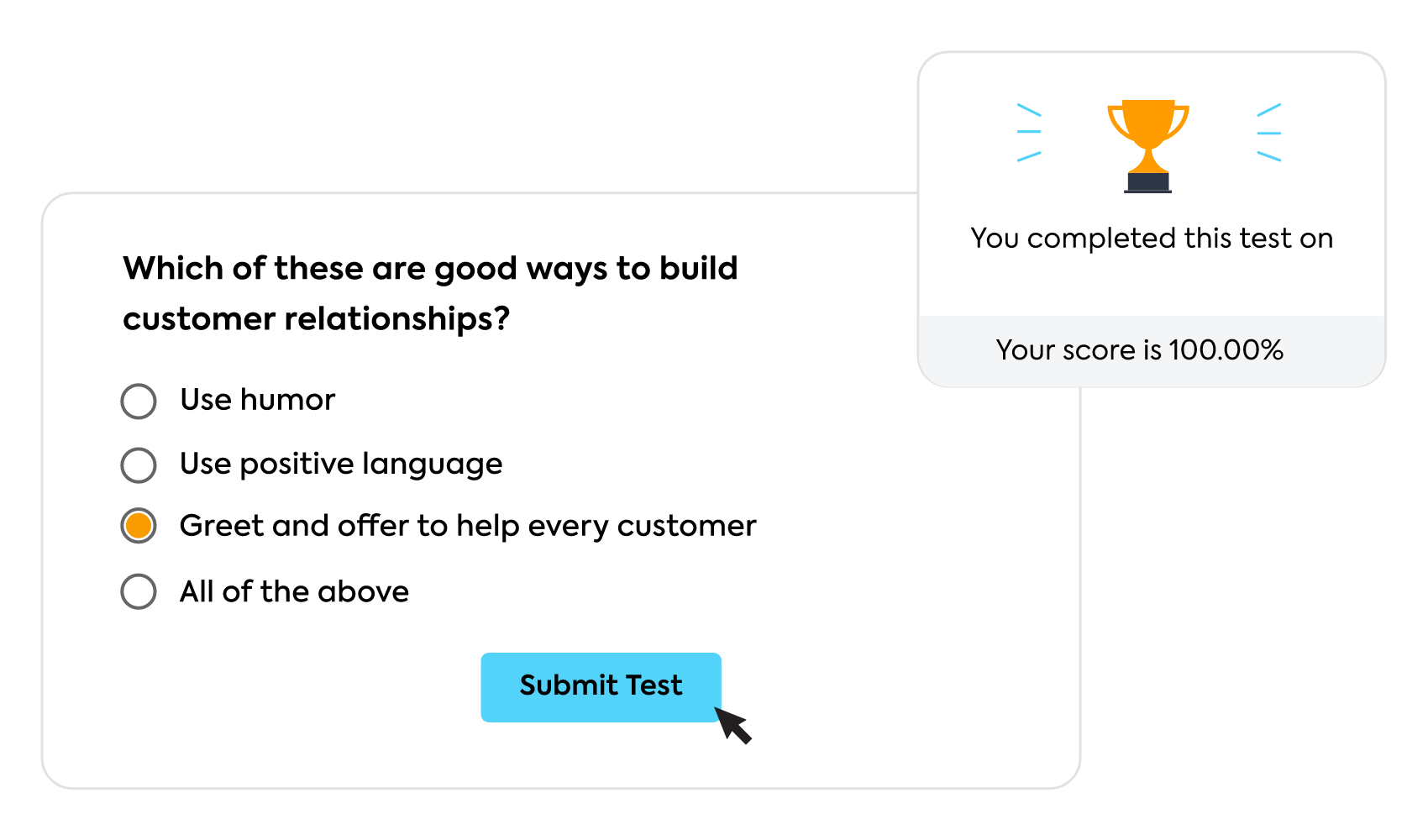
- Presentations and graphics. Sometimes it’s best to put the information out there where learners can examine it for themselves. Engaging slides and helpful graphics can make it easy to get information quickly. Just be sure to keep text minimal and avoid big blocks that will be hard to get through. Make colorful and interesting designs to hold people’s attention.
- Microlearning. Microlearning consists of bite-sized lessons focused on just one idea. They can be completed in just a few minutes via smart devices. These are ideal when you want to focus on core points and engage employees who don’t have a lot of time.
- Group discussions. You can conduct live sessions online where everyone logs on at the same time and the training is led by a facilitator. This is helpful for real-time group discussions and exercises. The trainer can also gauge in the moment what people are learning and adjust the pace as needed.
Let’s look at our customer service module example with these formats in mind. You might consider video-based content where employees see conversations with clients and sales techniques in action. Then, you could follow up with a quiz at the end of each lesson where they choose proper responses to given scenarios to help cement the skills they’ve learned.
Step 3: Create your training module template
Once you know what content you’ll use, it’s time to put it into a template. You can build one from scratch or save time and effort by choosing a premade one. If you’re using an LMS for training , you should be able to easily plug in content and get up and running quickly.
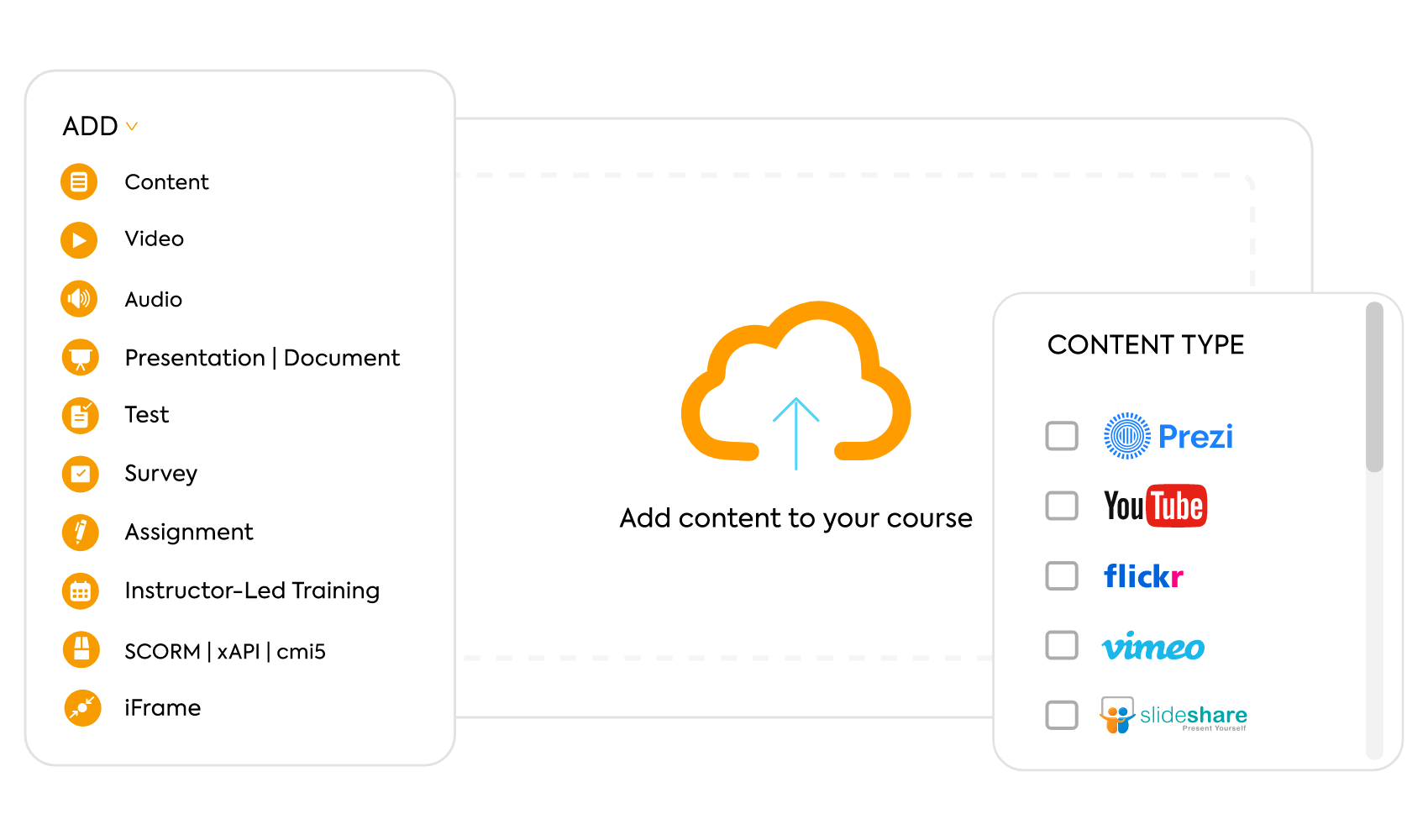
You can re-use templates from previous modules for consistency. Or, try out something new but maintain the look and feel of the rest of the course with custom branding and design.
Step 4: Roll out your training
Now that you’ve got your training module ready, it’s time to make it available to all your learners. Provide access through your LMS so people can log in and join easily.
Look for an LMS that can send out invitations and reminders to learners. It should also be able to help people track their progress to make it easy to pick up where they left off and complete the training quickly.
Step 5: Measure your results
It’s important to track training metrics so you know whether your module is achieving your objectives. Look at things like:
- Completion rates
- Quiz scores
- Time-to-completion numbers
- Where people may be stalling or dropping out of training
This information will help you see what’s working and also identify areas that may need a little work.
Your LMS can help automate measurements . Use the reporting feature to easily generate and analyze metrics so you can pick out patterns.
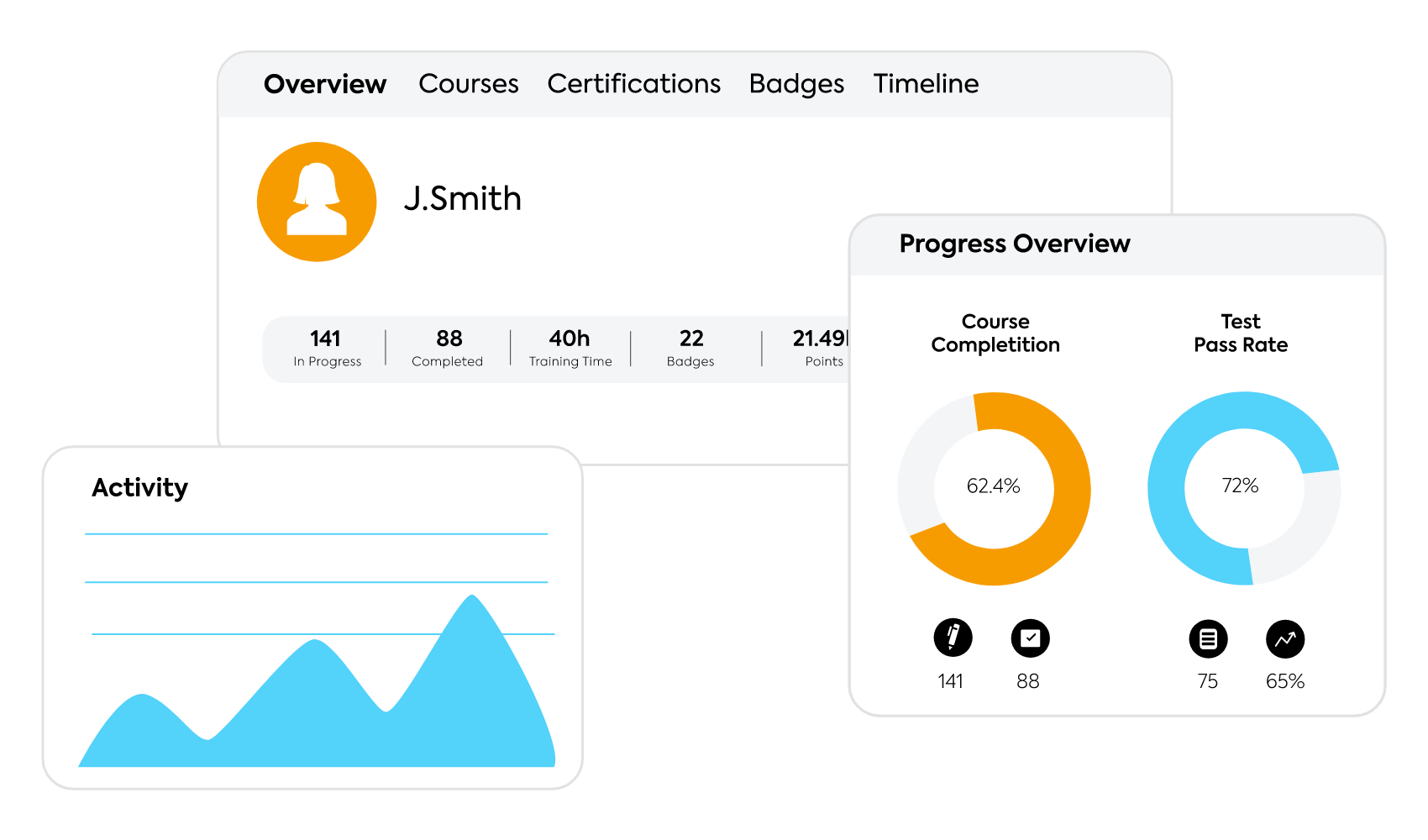
You can also get valuable information directly from your employees. Survey learners about their experience. Ask about the content, but also about useability. Listen to the feedback and explore how you could improve the experience and make it easier and more meaningful.
Template for planning your training module
Creating a new module starts with planning. Consider all of these elements as you begin:
- Topic: What specific information will you cover in this module? Where does it fit within the overall course?
- Audience: Who will go through your module? Make sure with training modules for employees that you include departments or groups the content will apply to.
- Lessons: How many lessons will you include within the module? Consider how much information you need to cover and break it down into logical lessons.
- Goals: Record learning objectives for each lesson within the module.
- Format: What type of content will you use for the module or each lesson within the module?
Include any other helpful information about your specific audience or objectives. It’s a good idea to track all the information in one place for reference as you build out the module.
Here’s a module planning template to get you started:

Training modules are an investment in your company’s future
Creating training modules might seem like a lot of work at first. But they’ll save you time in the long run. Building and saving your modules in your training platform will let you re-use them in other courses or even repurpose them for different audiences.
When you take control of your training content , you ensure a learning experience that engages employees with relevant content and formats. And with the right training strategy, you’ll help your organization reach its goals as you grow the business.
Save time, frustration and money with TalentLMS, the most-affordable and user-friendly learning management system on the market. Try it for free for as long as you want and discover why our customers consistently give us 4.5 stars (out of 5!)
Try for free!
| Tags: eLearning Courses , eLearning Design
Christina Pavlou - Former Content Marketing Manager
Christina, ex-Content Marketing Manager at Epignosis, focuses on L&D, diversity, and enhancing workplace well-being. Learn how to improve your work environment. More by Christina!
You may also like

10 Steps to Create Your Own Learning Objects (L.O.s)

5 Ways to use Role-Playing in eLearning

What are virtual training labs and how do they work in eLearning?
Popular articles, training evaluation methods: a comprehensive guide to techniques & tools.
1 month ago by Elena Koumparaki, 23 mins to read
The definitive guide to new employee orientation
2 years ago by Christina Pavlou, 17 mins to read
Would you take a pay cut to keep working remotely? 62% say no.
2 years ago by Athena Marousis, 17 mins to read
The top 26 most used online employee training tools
2 years ago by Christina Pavlou, 11 mins to read
Training Objectives: 5 Tips To Set Realistic Goals For Your Training
1 month ago by Aris Apostolopoulos, 9 mins to read
We love social, let’s connect!
Start your elearning portal in 30 seconds.
Get started it's free!
TalentLMS is free to use for as long as you want! You can always upgrade to a paid plan to get much more!
Rely on quality and security best practices
- Integrations
- Mobile apps
- Why TalentLMS
- Get TalentLMS free
- TalentLibrary
- TalentCraft
- Course providers
- Research by TalentLMS
- Blended learning
- What is an LMS?
- Our customers
- Training Excellence Awards
- Customer success
Discover Epignosis software
- Help center
- Terms of Service

Developing a Business Plan
The foundation of a successful business is a solid business plan. This comprehensive course dives into the details of developing a plan and students emerge with a first draft of a sound business plan.
What you can learn.
- Learn the key components for creating a business plan
- Identify existing customers and future customers
- Understand revenue forecasting methodologies, competitor analysis, small business finance, and how to transition from personal guarantees and credit lines to a self-financing business model
- Effectively plan, hire, and train staff with high potential
- Examine the legal aspects of organizing and managing a small business
About this course:
Spring 2024 schedule.
No meeting May 14, 2023. Enrollment limited; early enrollment advised. Internet access required.
Enrollment limited; early enrollment advised. Internet access required. Materials required.
Summer 2024 Schedule
Enrollment limited; early enrollment advised. Internet access required.
This course applies towards the following certificates & specializations…

Corporate Education
Learn how we can help your organization meet its professional development goals and corporate training needs.
Donate to UCLA Extension
Support our many efforts to reach communities in need.
Innovation Programs
Student Scholarships
Coding Boot Camp
Lifelong Learning
- Accounting & Taxation
- Architecture & Interior Design
- Business & Management
- Design & Arts
- Digital Technology
- Engineering
- Entertainment
- Environmental Studies & Public Policy
- Finance & Investments
- Health Care & Counseling
- Humanities & Social Sciences
- Landscape Architecture & Horticulture
- Legal Programs
- Osher (OLLI)
- Real Estate
- Sciences & Math
- Writing & Journalism
- Specializations
- Online Courses
- Transfer Credit Courses
- Conferences & Boot Camps
- Custom Programs & Corporate Education
- Instruction Methods
- Environmental Studies
- Accounting Fundamentals
- Business and Management of Entertainment
- College Counseling
- Data Science
- Digital Marketing
- Feature Film Writing
- Human Resources Management
- Marketing with Concentration in Digital Marketing
- Personal Financial Planning
- Project Management
- Sustainability
- User Experience
- Payment Options
- How to Purchase Parking
- Enrollment Conditions
- Concurrent and Cross-Enrollment Programs
- Bruin ID Cards
- UCLA Recreation
- Course Drops, Transfers, and Withdrawals
- Accessibility & Disability Services
- Textbooks & Libraries
- Financial Aid
- Scholarships
- Military & Veterans Benefits
- Tuition Discounts
- Tax Advantages
- Grading Scale
- Credit Options
- Course Numbers
- Transcripts and Enrollment Confirmation
- Receiving Your Academic Credentials
- Instructors & Staff
- Parking & Lodging
- Keynote Speaker
- Career Resources
- Alumni Benefits
- Rights and Responsibilities
- Career Services
- Featured Jobs
- Browse Certificate Programs
- Certificate vs. Master’s Degrees
- Dates and Fees
- How to Apply
- Academic Requirements
- OPT, CPT, and Internships
- Upon Completing Your Certificate
- Hummel Scholarship
- Program Details
- Online International Programs
- International Student Services Office
- New Student Orientation
- Maintaining Your F-1 Visa
- Health Insurance
- Academic Advising
- Frequently Asked Questions
- UCLA Campus Amenities & Activities
- Daily Needs
- Public Transportation
- Request a Proposal
- Board of Advisors
- Instructors
- Join Our Team
- Equity, Diversity & Inclusion
- Accreditation
- Student Home
- Canvas Log In
- Student Log In
- Instructor Log In
Cookie Policy
We use cookies to understand how you use our site and to improve your experience, including personalizing content and to store your content preferences. By continuing to use our site, you accept our use of cookies. Read our privacy policy .

- 1-855-978-3988
- Book Appointment
- Request Info
- Accounting & Payroll
- Business & Management
- Coding & Programming
- Community Support & Education
- Customer Service & Hospitality
- English Language Training
- Health & Wellness
- Home Inspection
- Information Technology (IT)
- Legal Training
- Office & Administration
- Software & Web Development
- Visual & Applied Design
- Micro-credentials
- All Locations
- Brampton East
- Brampton West
- Mississauga East
- Mississauga West
- North York – Eglinton
- Scarborough – McCowan and 401
- Toronto – Bay & Queen
- Toronto – Albion & Islington
- Toronto – Downsview
- Toronto – Lawrence
- Calgary Central
- Calgary Genesis Centre
- Edmonton South
- Edmonton West
- Medicine Hat
- North Vancouver
- Vancouver Broadway Station
- Victoria Westshore
- Charlottetown
- Winnipeg North
- Winnipeg South
- Learn about AOLCC
- Integrated Learning System
- Financial Aid
- International Students
- Job Placement Assistance
- Policies and Procedures
- Request Official Documents
- Career Services
- Apply to Study
- Campus News
- Growth Mindset
- How Does Memory Work?
- BONUS: International Women’s Day
- AOLCC Success Stories
- About Our Graduates
- Franchise Opportunities
Business Planning
Course info:, course introduction.
This course will assist students in learning the fundamentals of effective business planning. It teaches students the concepts they need to understand in order to properly assess a new business idea and make it yield results. Several skill-building exercises help to put the theory into practice. Topics covered include organizing a business plan, choosing a business name, developing a mission statement and executive summary, analyzing the environmental factors that can affect a business, marketing the business, and managing people and the competition. Students are provided the opportunity to apply and develop their business planning knowledge through the completion of tasks and review questions.
Course Prerequisites
Course notes.
Course manual provided for on-going reference. There is a final exam upon completion of the course. Participants who receive 75% or higher on their exam will receive a certificate.
Course Breakdown
Module 1: Small Business and Entrepreneurs; The Business Plan; Why Business Planning?; Entrepreneurial Characteristics and Personal Assessments; Success and Failure
Module 2: Business Options; Business Legal Structures; Choosing a Name and Registering for Licenses and Permits; Patents, Copyright, and Trademarks; Defining Your Real Business; Budgeting and Financial Planning
Module 3: The Mission Statement; The Executive Summary; Ideas, Trends, and the Product Life Cycle; Environmental Factors
Module 4: The Marketing Process; Marketing Strategy and the Marketing Mix; Market Segmentation and Your Target Market; Setting Goals and Objectives
Module 5: The Marketing Mix and the Environmental Framework; Products and Services; Price; Place; Promotion
Module 6: Building a Team; Managing People; Selecting Professional Advisors; The Competition; Positioning
Program: Business Programs
Course Aim: To give the student the skills required to make a small enterprise succeed.
Of interest to: Those who are interested in starting a new business, or in providing better planning to an existing business.
Method of Delivery: Integrated Learning™ System (ILSPlus) training facilitated by Academy of Learning Career College facilitators.
Contact us for more information
And we'll get back to you within 48 hours.
Available Locations
This Course is offered at multiple locations across the country.
Click Here to see all locations.
Find out more about this Program
11.4 The Business Plan
Learning objectives.
By the end of this section, you will be able to:
- Describe the different purposes of a business plan
- Describe and develop the components of a brief business plan
- Describe and develop the components of a full business plan
Unlike the brief or lean formats introduced so far, the business plan is a formal document used for the long-range planning of a company’s operation. It typically includes background information, financial information, and a summary of the business. Investors nearly always request a formal business plan because it is an integral part of their evaluation of whether to invest in a company. Although nothing in business is permanent, a business plan typically has components that are more “set in stone” than a business model canvas , which is more commonly used as a first step in the planning process and throughout the early stages of a nascent business. A business plan is likely to describe the business and industry, market strategies, sales potential, and competitive analysis, as well as the company’s long-term goals and objectives. An in-depth formal business plan would follow at later stages after various iterations to business model canvases. The business plan usually projects financial data over a three-year period and is typically required by banks or other investors to secure funding. The business plan is a roadmap for the company to follow over multiple years.
Some entrepreneurs prefer to use the canvas process instead of the business plan, whereas others use a shorter version of the business plan, submitting it to investors after several iterations. There are also entrepreneurs who use the business plan earlier in the entrepreneurial process, either preceding or concurrently with a canvas. For instance, Chris Guillebeau has a one-page business plan template in his book The $100 Startup . 48 His version is basically an extension of a napkin sketch without the detail of a full business plan. As you progress, you can also consider a brief business plan (about two pages)—if you want to support a rapid business launch—and/or a standard business plan.
As with many aspects of entrepreneurship, there are no clear hard and fast rules to achieving entrepreneurial success. You may encounter different people who want different things (canvas, summary, full business plan), and you also have flexibility in following whatever tool works best for you. Like the canvas, the various versions of the business plan are tools that will aid you in your entrepreneurial endeavor.
Business Plan Overview
Most business plans have several distinct sections ( Figure 11.16 ). The business plan can range from a few pages to twenty-five pages or more, depending on the purpose and the intended audience. For our discussion, we’ll describe a brief business plan and a standard business plan. If you are able to successfully design a business model canvas, then you will have the structure for developing a clear business plan that you can submit for financial consideration.
Both types of business plans aim at providing a picture and roadmap to follow from conception to creation. If you opt for the brief business plan, you will focus primarily on articulating a big-picture overview of your business concept.
The full business plan is aimed at executing the vision concept, dealing with the proverbial devil in the details. Developing a full business plan will assist those of you who need a more detailed and structured roadmap, or those of you with little to no background in business. The business planning process includes the business model, a feasibility analysis, and a full business plan, which we will discuss later in this section. Next, we explore how a business plan can meet several different needs.
Purposes of a Business Plan
A business plan can serve many different purposes—some internal, others external. As we discussed previously, you can use a business plan as an internal early planning device, an extension of a napkin sketch, and as a follow-up to one of the canvas tools. A business plan can be an organizational roadmap , that is, an internal planning tool and working plan that you can apply to your business in order to reach your desired goals over the course of several years. The business plan should be written by the owners of the venture, since it forces a firsthand examination of the business operations and allows them to focus on areas that need improvement.
Refer to the business venture throughout the document. Generally speaking, a business plan should not be written in the first person.
A major external purpose for the business plan is as an investment tool that outlines financial projections, becoming a document designed to attract investors. In many instances, a business plan can complement a formal investor’s pitch. In this context, the business plan is a presentation plan, intended for an outside audience that may or may not be familiar with your industry, your business, and your competitors.
You can also use your business plan as a contingency plan by outlining some “what-if” scenarios and exploring how you might respond if these scenarios unfold. Pretty Young Professional launched in November 2010 as an online resource to guide an emerging generation of female leaders. The site focused on recent female college graduates and current students searching for professional roles and those in their first professional roles. It was founded by four friends who were coworkers at the global consultancy firm McKinsey. But after positions and equity were decided among them, fundamental differences of opinion about the direction of the business emerged between two factions, according to the cofounder and former CEO Kathryn Minshew . “I think, naively, we assumed that if we kicked the can down the road on some of those things, we’d be able to sort them out,” Minshew said. Minshew went on to found a different professional site, The Muse , and took much of the editorial team of Pretty Young Professional with her. 49 Whereas greater planning potentially could have prevented the early demise of Pretty Young Professional, a change in planning led to overnight success for Joshua Esnard and The Cut Buddy team. Esnard invented and patented the plastic hair template that he was selling online out of his Fort Lauderdale garage while working a full-time job at Broward College and running a side business. Esnard had hundreds of boxes of Cut Buddies sitting in his home when he changed his marketing plan to enlist companies specializing in making videos go viral. It worked so well that a promotional video for the product garnered 8 million views in hours. The Cut Buddy sold over 4,000 products in a few hours when Esnard only had hundreds remaining. Demand greatly exceeded his supply, so Esnard had to scramble to increase manufacturing and offered customers two-for-one deals to make up for delays. This led to selling 55,000 units, generating $700,000 in sales in 2017. 50 After appearing on Shark Tank and landing a deal with Daymond John that gave the “shark” a 20-percent equity stake in return for $300,000, The Cut Buddy has added new distribution channels to include retail sales along with online commerce. Changing one aspect of a business plan—the marketing plan—yielded success for The Cut Buddy.
Link to Learning
Watch this video of Cut Buddy’s founder, Joshua Esnard, telling his company’s story to learn more.
If you opt for the brief business plan, you will focus primarily on articulating a big-picture overview of your business concept. This version is used to interest potential investors, employees, and other stakeholders, and will include a financial summary “box,” but it must have a disclaimer, and the founder/entrepreneur may need to have the people who receive it sign a nondisclosure agreement (NDA) . The full business plan is aimed at executing the vision concept, providing supporting details, and would be required by financial institutions and others as they formally become stakeholders in the venture. Both are aimed at providing a picture and roadmap to go from conception to creation.
Types of Business Plans
The brief business plan is similar to an extended executive summary from the full business plan. This concise document provides a broad overview of your entrepreneurial concept, your team members, how and why you will execute on your plans, and why you are the ones to do so. You can think of a brief business plan as a scene setter or—since we began this chapter with a film reference—as a trailer to the full movie. The brief business plan is the commercial equivalent to a trailer for Field of Dreams , whereas the full plan is the full-length movie equivalent.
Brief Business Plan or Executive Summary
As the name implies, the brief business plan or executive summary summarizes key elements of the entire business plan, such as the business concept, financial features, and current business position. The executive summary version of the business plan is your opportunity to broadly articulate the overall concept and vision of the company for yourself, for prospective investors, and for current and future employees.
A typical executive summary is generally no longer than a page, but because the brief business plan is essentially an extended executive summary, the executive summary section is vital. This is the “ask” to an investor. You should begin by clearly stating what you are asking for in the summary.
In the business concept phase, you’ll describe the business, its product, and its markets. Describe the customer segment it serves and why your company will hold a competitive advantage. This section may align roughly with the customer segments and value-proposition segments of a canvas.
Next, highlight the important financial features, including sales, profits, cash flows, and return on investment. Like the financial portion of a feasibility analysis, the financial analysis component of a business plan may typically include items like a twelve-month profit and loss projection, a three- or four-year profit and loss projection, a cash-flow projection, a projected balance sheet, and a breakeven calculation. You can explore a feasibility study and financial projections in more depth in the formal business plan. Here, you want to focus on the big picture of your numbers and what they mean.
The current business position section can furnish relevant information about you and your team members and the company at large. This is your opportunity to tell the story of how you formed the company, to describe its legal status (form of operation), and to list the principal players. In one part of the extended executive summary, you can cover your reasons for starting the business: Here is an opportunity to clearly define the needs you think you can meet and perhaps get into the pains and gains of customers. You also can provide a summary of the overall strategic direction in which you intend to take the company. Describe the company’s mission, vision, goals and objectives, overall business model, and value proposition.
Rice University’s Student Business Plan Competition, one of the largest and overall best-regarded graduate school business-plan competitions (see Telling Your Entrepreneurial Story and Pitching the Idea ), requires an executive summary of up to five pages to apply. 51 , 52 Its suggested sections are shown in Table 11.2 .
Are You Ready?
Create a brief business plan.
Fill out a canvas of your choosing for a well-known startup: Uber, Netflix, Dropbox, Etsy, Airbnb, Bird/Lime, Warby Parker, or any of the companies featured throughout this chapter or one of your choice. Then create a brief business plan for that business. See if you can find a version of the company’s actual executive summary, business plan, or canvas. Compare and contrast your vision with what the company has articulated.
- These companies are well established but is there a component of what you charted that you would advise the company to change to ensure future viability?
- Map out a contingency plan for a “what-if” scenario if one key aspect of the company or the environment it operates in were drastically is altered?
Full Business Plan
Even full business plans can vary in length, scale, and scope. Rice University sets a ten-page cap on business plans submitted for the full competition. The IndUS Entrepreneurs , one of the largest global networks of entrepreneurs, also holds business plan competitions for students through its Tie Young Entrepreneurs program. In contrast, business plans submitted for that competition can usually be up to twenty-five pages. These are just two examples. Some components may differ slightly; common elements are typically found in a formal business plan outline. The next section will provide sample components of a full business plan for a fictional business.
Executive Summary
The executive summary should provide an overview of your business with key points and issues. Because the summary is intended to summarize the entire document, it is most helpful to write this section last, even though it comes first in sequence. The writing in this section should be especially concise. Readers should be able to understand your needs and capabilities at first glance. The section should tell the reader what you want and your “ask” should be explicitly stated in the summary.
Describe your business, its product or service, and the intended customers. Explain what will be sold, who it will be sold to, and what competitive advantages the business has. Table 11.3 shows a sample executive summary for the fictional company La Vida Lola.
Business Description
This section describes the industry, your product, and the business and success factors. It should provide a current outlook as well as future trends and developments. You also should address your company’s mission, vision, goals, and objectives. Summarize your overall strategic direction, your reasons for starting the business, a description of your products and services, your business model, and your company’s value proposition. Consider including the Standard Industrial Classification/North American Industry Classification System (SIC/NAICS) code to specify the industry and insure correct identification. The industry extends beyond where the business is located and operates, and should include national and global dynamics. Table 11.4 shows a sample business description for La Vida Lola.
Industry Analysis and Market Strategies
Here you should define your market in terms of size, structure, growth prospects, trends, and sales potential. You’ll want to include your TAM and forecast the SAM . (Both these terms are discussed in Conducting a Feasibility Analysis .) This is a place to address market segmentation strategies by geography, customer attributes, or product orientation. Describe your positioning relative to your competitors’ in terms of pricing, distribution, promotion plan, and sales potential. Table 11.5 shows an example industry analysis and market strategy for La Vida Lola.
Competitive Analysis
The competitive analysis is a statement of the business strategy as it relates to the competition. You want to be able to identify who are your major competitors and assess what are their market shares, markets served, strategies employed, and expected response to entry? You likely want to conduct a classic SWOT analysis (Strengths Weaknesses Opportunities Threats) and complete a competitive-strength grid or competitive matrix. Outline your company’s competitive strengths relative to those of the competition in regard to product, distribution, pricing, promotion, and advertising. What are your company’s competitive advantages and their likely impacts on its success? The key is to construct it properly for the relevant features/benefits (by weight, according to customers) and how the startup compares to incumbents. The competitive matrix should show clearly how and why the startup has a clear (if not currently measurable) competitive advantage. Some common features in the example include price, benefits, quality, type of features, locations, and distribution/sales. Sample templates are shown in Figure 11.17 and Figure 11.18 . A competitive analysis helps you create a marketing strategy that will identify assets or skills that your competitors are lacking so you can plan to fill those gaps, giving you a distinct competitive advantage. When creating a competitor analysis, it is important to focus on the key features and elements that matter to customers, rather than focusing too heavily on the entrepreneur’s idea and desires.
Operations and Management Plan
In this section, outline how you will manage your company. Describe its organizational structure. Here you can address the form of ownership and, if warranted, include an organizational chart/structure. Highlight the backgrounds, experiences, qualifications, areas of expertise, and roles of members of the management team. This is also the place to mention any other stakeholders, such as a board of directors or advisory board(s), and their relevant relationship to the founder, experience and value to help make the venture successful, and professional service firms providing management support, such as accounting services and legal counsel.
Table 11.6 shows a sample operations and management plan for La Vida Lola.
Marketing Plan
Here you should outline and describe an effective overall marketing strategy for your venture, providing details regarding pricing, promotion, advertising, distribution, media usage, public relations, and a digital presence. Fully describe your sales management plan and the composition of your sales force, along with a comprehensive and detailed budget for the marketing plan. Table 11.7 shows a sample marketing plan for La Vida Lola.
Financial Plan
A financial plan seeks to forecast revenue and expenses; project a financial narrative; and estimate project costs, valuations, and cash flow projections. This section should present an accurate, realistic, and achievable financial plan for your venture (see Entrepreneurial Finance and Accounting for detailed discussions about conducting these projections). Include sales forecasts and income projections, pro forma financial statements ( Building the Entrepreneurial Dream Team , a breakeven analysis, and a capital budget. Identify your possible sources of financing (discussed in Conducting a Feasibility Analysis ). Figure 11.19 shows a template of cash-flow needs for La Vida Lola.
Entrepreneur In Action
Laughing man coffee.
Hugh Jackman ( Figure 11.20 ) may best be known for portraying a comic-book superhero who used his mutant abilities to protect the world from villains. But the Wolverine actor is also working to make the planet a better place for real, not through adamantium claws but through social entrepreneurship.
A love of java jolted Jackman into action in 2009, when he traveled to Ethiopia with a Christian humanitarian group to shoot a documentary about the impact of fair-trade certification on coffee growers there. He decided to launch a business and follow in the footsteps of the late Paul Newman, another famous actor turned philanthropist via food ventures.
Jackman launched Laughing Man Coffee two years later; he sold the line to Keurig in 2015. One Laughing Man Coffee café in New York continues to operate independently, investing its proceeds into charitable programs that support better housing, health, and educational initiatives within fair-trade farming communities. 55 Although the New York location is the only café, the coffee brand is still distributed, with Keurig donating an undisclosed portion of Laughing Man proceeds to those causes (whereas Jackman donates all his profits). The company initially donated its profits to World Vision, the Christian humanitarian group Jackman accompanied in 2009. In 2017, it created the Laughing Man Foundation to be more active with its money management and distribution.
- You be the entrepreneur. If you were Jackman, would you have sold the company to Keurig? Why or why not?
- Would you have started the Laughing Man Foundation?
- What else can Jackman do to aid fair-trade practices for coffee growers?
What Can You Do?
Textbooks for change.
Founded in 2014, Textbooks for Change uses a cross-compensation model, in which one customer segment pays for a product or service, and the profit from that revenue is used to provide the same product or service to another, underserved segment. Textbooks for Change partners with student organizations to collect used college textbooks, some of which are re-sold while others are donated to students in need at underserved universities across the globe. The organization has reused or recycled 250,000 textbooks, providing 220,000 students with access through seven campus partners in East Africa. This B-corp social enterprise tackles a problem and offers a solution that is directly relevant to college students like yourself. Have you observed a problem on your college campus or other campuses that is not being served properly? Could it result in a social enterprise?
Work It Out
Franchisee set out.
A franchisee of East Coast Wings, a chain with dozens of restaurants in the United States, has decided to part ways with the chain. The new store will feature the same basic sports-bar-and-restaurant concept and serve the same basic foods: chicken wings, burgers, sandwiches, and the like. The new restaurant can’t rely on the same distributors and suppliers. A new business plan is needed.
- What steps should the new restaurant take to create a new business plan?
- Should it attempt to serve the same customers? Why or why not?
This New York Times video, “An Unlikely Business Plan,” describes entrepreneurial resurgence in Detroit, Michigan.
- 48 Chris Guillebeau. The $100 Startup: Reinvent the Way You Make a Living, Do What You Love, and Create a New Future . New York: Crown Business/Random House, 2012.
- 49 Jonathan Chan. “What These 4 Startup Case Studies Can Teach You about Failure.” Foundr.com . July 12, 2015. https://foundr.com/4-startup-case-studies-failure/
- 50 Amy Feldman. “Inventor of the Cut Buddy Paid YouTubers to Spark Sales. He Wasn’t Ready for a Video to Go Viral.” Forbes. February 15, 2017. https://www.forbes.com/sites/forbestreptalks/2017/02/15/inventor-of-the-cut-buddy-paid-youtubers-to-spark-sales-he-wasnt-ready-for-a-video-to-go-viral/#3eb540ce798a
- 51 Jennifer Post. “National Business Plan Competitions for Entrepreneurs.” Business News Daily . August 30, 2018. https://www.businessnewsdaily.com/6902-business-plan-competitions-entrepreneurs.html
- 52 “Rice Business Plan Competition, Eligibility Criteria and How to Apply.” Rice Business Plan Competition . March 2020. https://rbpc.rice.edu/sites/g/files/bxs806/f/2020%20RBPC%20Eligibility%20Criteria%20and%20How%20to%20Apply_23Oct19.pdf
- 53 “Rice Business Plan Competition, Eligibility Criteria and How to Apply.” Rice Business Plan Competition. March 2020. https://rbpc.rice.edu/sites/g/files/bxs806/f/2020%20RBPC%20Eligibility%20Criteria%20and%20How%20to%20Apply_23Oct19.pdf; Based on 2019 RBPC Competition Rules and Format April 4–6, 2019. https://rbpc.rice.edu/sites/g/files/bxs806/f/2019-RBPC-Competition-Rules%20-Format.pdf
- 54 Foodstart. http://foodstart.com
- 55 “Hugh Jackman Journey to Starting a Social Enterprise Coffee Company.” Giving Compass. April 8, 2018. https://givingcompass.org/article/hugh-jackman-journey-to-starting-a-social-enterprise-coffee-company/
As an Amazon Associate we earn from qualifying purchases.
This book may not be used in the training of large language models or otherwise be ingested into large language models or generative AI offerings without OpenStax's permission.
Want to cite, share, or modify this book? This book uses the Creative Commons Attribution License and you must attribute OpenStax.
Access for free at https://openstax.org/books/entrepreneurship/pages/1-introduction
- Authors: Michael Laverty, Chris Littel
- Publisher/website: OpenStax
- Book title: Entrepreneurship
- Publication date: Jan 16, 2020
- Location: Houston, Texas
- Book URL: https://openstax.org/books/entrepreneurship/pages/1-introduction
- Section URL: https://openstax.org/books/entrepreneurship/pages/11-4-the-business-plan
© Jan 4, 2024 OpenStax. Textbook content produced by OpenStax is licensed under a Creative Commons Attribution License . The OpenStax name, OpenStax logo, OpenStax book covers, OpenStax CNX name, and OpenStax CNX logo are not subject to the Creative Commons license and may not be reproduced without the prior and express written consent of Rice University.
Zoe Talent Solutions
The complete business plan writing and development training course.

Course Overview
Course outline, book classes now.
Planning is one of the most crucial steps before starting a business. Every successful business has a lot of effective planning behind it. It can be about launching a new product, service, or a completely new business. The business plan is written keeping in mind the goals, strategies, priorities and business objectives.
How will this course help the participants? It will help the participants to understand their business in detail, analyze the market and competition, find a mission and vision statement, create an effective pitch for investors, create an effective marketing plan, forecast their finances and finally complete their business plan.
This Zoe training course will empower you with your thoughts and strategies to write the most effective business plan. This course is a step by step guide to your business plan which will help you in making your business profitable.
Also Explore Other Courses
- Strategic Thinking and Planning Training Course
- Disruptive Innovation Course
- Due Diligence Training Course
The Certified Strategist: From Planning to Execution
Business process improvement training course, course objectives.
Upon completing this ‘Complete Business Plan Writing and Development Training Course’ successfully, participants will be able to:
- Understand the steps and different formats of business plan writing
- Design and construct a detailed written business plan
- Write your business plan that contains the most effective business strategies
- Create and deliver an effective oral presentation of your business plan
- Save money by not having to buy business plan templates or hire a business plan consultant
- Create a strong business model and find your target market
- Design a budget oriented plan for your business
Training Methodology
This collaborative ‘Complete Business Plan Writing and Development Training Course’ will comprise of the following training methods:
- Presentations & Seminars
- Assignments
- Case Studies
Zoe Talent Solutions follows the ‘Do-Review-Learn-Apply’ model.
Organizational Benefits
Companies who nominate their employees to participate in this ‘Complete Business Plan Writing and Development Training Course’ can benefit in the following ways:
- Improved business planning for new and existing business verticals
- Clear priorities and goals to work upon
- Better Cash Management
- Clarity in overall picture of the business
- Focused Strategy to run a profitable business
Personal Benefits
Individuals who participate in this ‘Complete Business Plan Writing and Development Training Course’ can gain from it in the following ways:
- Prepare yourself to play a key role in keeping your company ahead by studying high-impact business planning
- Gain relevant writing and planning skills to develop and implement business strategies
- Sharpen your mindset to overcome the challenges while thinking, writing and designing the effective business plan
- Learn to create a great strategy before starting your business

Who Should Attend?
This ‘Complete Business Plan Writing and Development Training Course’ would be suitable for:
- Aspiring entrepreneurs
- Business Heads
- Business Plan Consultants
- Freelancers
- An existing company looking for a new business launch
MODULE 1: INTRODUCTION TO BUSINESS PLAN WRITING AND DEVELOPMENT
- A brief description of your business
- What is a Business Plan?
- Why do we need a business plan?
MODULE 2: TYPES OF BUSINESS PLAN
- Mini Business Plan
- Presentation Business Plan
- Detailed Plan
- Backup Plan
MODULE 3: Parts of a Business Plan-1
- Executive Summary
- Company Description
- Market Analysis – Determining your market size
MODULE 4: Parts of a Business Plan-2
- Competition Analysis
- Products and Service Description
- Sales Funnel
- Marketing Time
MODULE 5: Parts of a Business Plan-3
- How will my business make money?
- SWOT Analysis
- Pricing of a Product or Service
- Financial Projection
MODULE 6: Financial Planning in Detail
- Cash Flow Statement
- Forecasting of existing businesses
- Forecasting of a new business
- Models of the change process
- Profit Calculation in a business plan
- Balance Sheet
MODULE 7: Marketing Plan in Detail
- Types of Marketing
- Planning Offline Marketing
- Planning Digital Marketing
- How to Effectively Use Social Media Marketing?
MODULE 8: Write Your 1 st Business Plan
- Templates of Business Plan
- Examples and Case Studies
- Inverted Pyramid Model
- Step by Step writing of 1 st business plan
- Review and feedback
Share This Content
Click here to auto generate invoice for this course
Get a free proposal to conduct this course in your organisation as an in-house basis
If you've any questions, Let us know by clicking the button below.
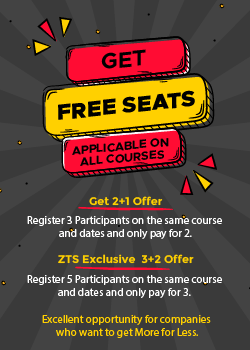
Customized Schedule is available for all courses irrespective of dates on the Calendar. Please get in touch with us for details.
Related Courses

Strategic Awareness and Business Acumen Training Course

Balanced Scorecard (BSC) Training Course

Improving Board Effectiveness Training

Board of Directors and Members Training Course

Strategic Thinking and Business Planning Course

Process Management Training Course

Corporate Resilience Training for Managers and Organisations

Zoe Talent Solution uses cookies to ensure you get the best experience on our website | Terms & Conditions Got it!
You’re using an older browser version. Update to the latest version of Google Chrome , Safari , Mozilla Firefox , or Microsoft Edge for the best site experience.
- eLearning Blog
- eLearning Basics
- Instructional Design
- Corporate Training
- Course Selling
- Manufacturing
- Products iSpring Suite iSpring Learn
- Use Cases Onboarding Compliance Training Induction Training Product Training Channel Partner Training Sales Training Microlearning Mobile Learning
- Company About Us Case Studies Customers Partnership Course Development Contact Us Academy Blog Webinars Guides
- Community Academy Blog Webinars Guides Experts on iSpring
- Language EN English Français Deutsch Español Italiano Nederlands Português Polski 中文 日本語 العربية Indonesia
- Shopping Cart
Free Online eLearning Conference | May 2nd–3rd
iSPRING DAYS 2024
Seize the human-centric future of learning
How to Develop Training Module: A Step-by-Step Guide

Table of Contents

Types of Training Modules
Offering a variety of content types allows you to create a richer training experience for all of your learners. Here are some examples of online training modules and tips on how to utilize them:
1. Informational e-course
An informational eLearning course is a popular online training module that typically represents a set of slides with text, pictures, and “Next” buttons. This provides learners with information on a specific topic. When you create such an online training module, focus on its clarity of look and optimal length to help learners focus on the learning topic better.
Example of an informational e-course
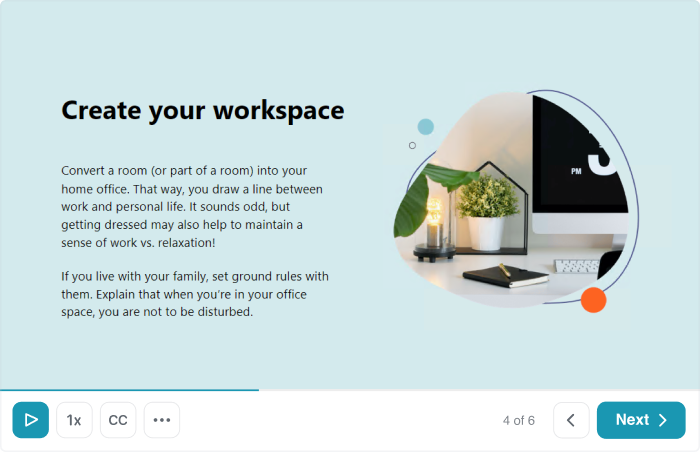
A ‘Work from Home’ course made with iSpring Suite
Check out a online training module→
Best suited for
- Delivering standardized knowledge, such as onboarding, safety, security awareness, or compliance training .
- Providing information on a new product, technology, or policy update.
2. Interactive assessment
Interactive assessments are a type of online quiz that incorporates a variety of question types , custom branching, and scenarios. The more these quizzes engage learners by prompting them to move, compare, or choose objects, the better it is for learning experience. So, it may be a good idea to use multiple-choice , true or false , fill-in-the-blank , drag-and-drop , matching , and sequencing question types.
Example of an interactive assessment
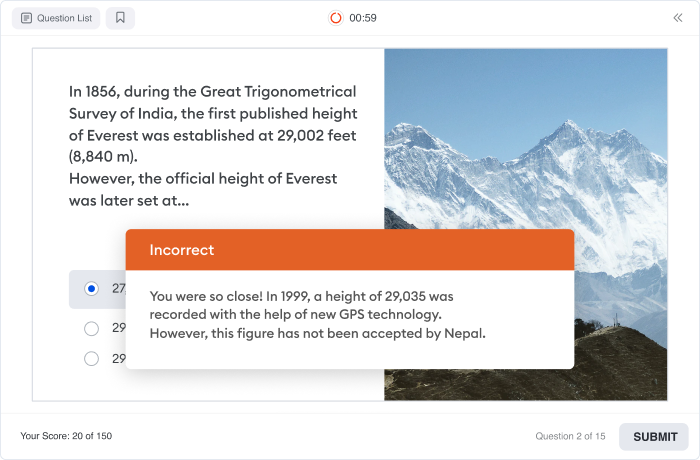
Check out a complete learning module →
- Measuring your learners’ level of knowledge relevant to their work and/or ability to apply knowledge.
- Challenging tasks that require certification or credentialing.
- Proof of completion of learning activities.
- Identifying learners who may need additional support.
3. FAQ interaction
An FAQ interaction is a layout that gives users one-click access to reference information and frequently asked questions on a specific topic. You can present an FAQ interaction as a series of questions and answers or a list of topics and details. You can also add keywords to your FAQ interaction to enhance search functionality within your online course.
Example of an FAQ interaction
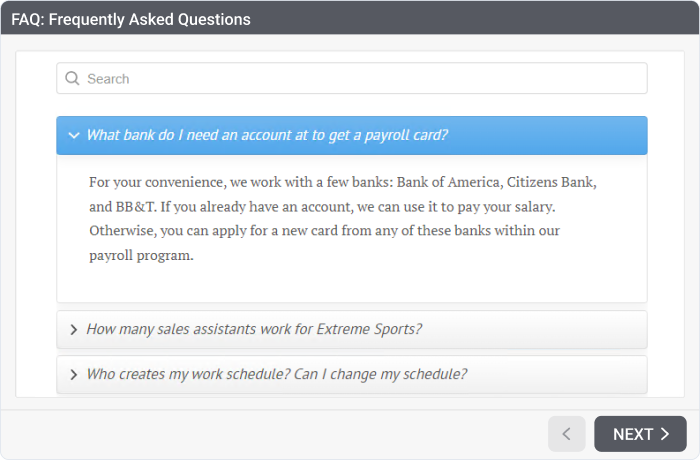
An FAQ ready-made template in iSpring Suite
- Creating a standard format to organize and present basic information.
- Glossaries, definitions, or other basic knowledge-level facts.
- Providing information that is additional to the main content of the course.
4. Video lectures and screencasts
If you opt for a video-based format of training, chances are it will be video lectures and screencasts. A video lecture is an instructional video that has been recorded and saved for viewing at a later date.
Example of a video lecture

Check out a complete learning module →
A screencast is a video recording which captures the actions that take place on a screen, like accessing programs or navigating certain features.
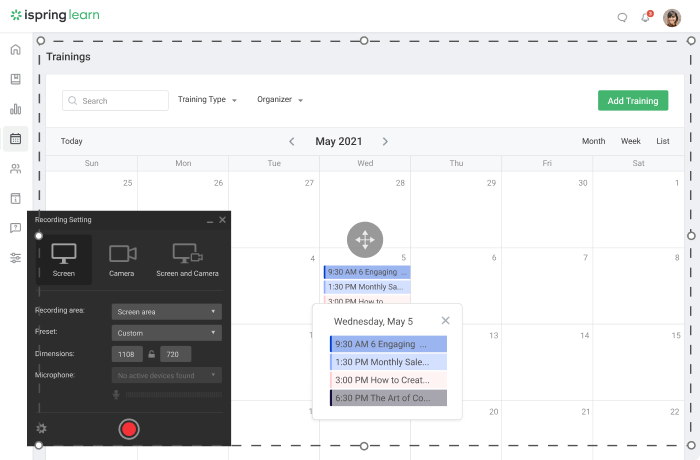
Tutorials to demonstrate basic business tasks, such as how to access programs, how to navigate through an online system, or how to fill out forms.
- Providing a large audience of learners with access to a particular portion of knowledge, like a lesson.
- Creating an effect of presence and enhancing comprehension.
Also read: → The Ultimate Guide to Lecture Capture
5. Role-play scenarios
Role-play scenarios help your learners build communication skills by applying their knowledge in conversations with colleagues and customers and measure their performance. They are basically dialogue scenes with branching scenarios that immerse learners into practicing in a realistic, yet risk-free environment, which is perfect for sales training.
Example of a dialogue simulation

Check out a complete learning module→
- Customer service and sales teams, for developing customer relationships and closing sales.
- Educating coaches and instructors who have to communicate information systematically to individuals or audiences.
Also read :→ Retail Sales Training – How to Move It Online
6. Microlearning module
A microlearning module is a bite-size lesson that provides a focused answer to a single problem or question. It can usually be completed in about five minutes at the point of need. If it is too long, it’s better to break it down into smaller pieces.
Example of a microlearning module

- Employee training during an idle moment and immediate practice of the new knowledge.
- Taking courses about a new product or services, updated policy, or new terms super quick.
- Providing the basics of a learning topic prior to face-to-face training sessions.
7. Digital job aid
A digital job aid is a document or presentation that is accessible virtually and can be played, downloaded, saved, or printed by the learner. Typically, it can be a flipbook made from Word, PPT, or PDF files.
Example of a digital job aid
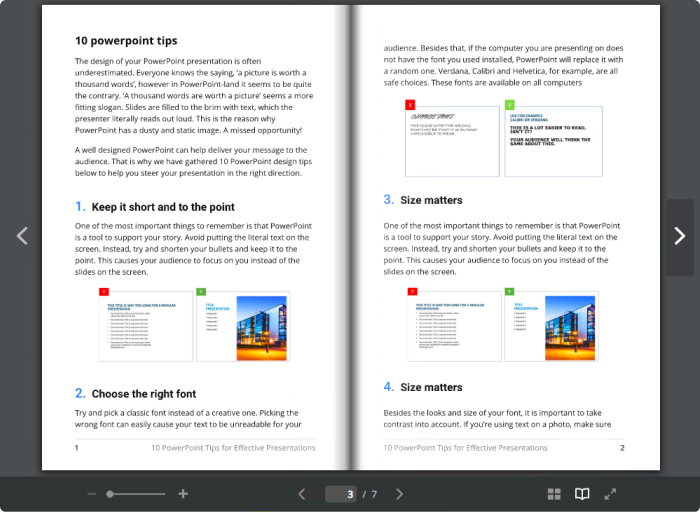
- Accessing manuals, guides, instructions on mobile devices, or on an internal drive.
- Microlearning initiatives within a company.
Also read : → 5 Types of Employee Training
How to Develop Training Modules
Creating the best training module requires careful planning and execution. In this step-by-step guide, we will walk you through the process of developing an effective training module.
Whether you are a seasoned instructional designer or new to creating online training modules, this guide will provide you with valuable insights and practical tips to create a training module.
Step 1: Define the Problem
The first rule of training success is: Solve the right business problem!
Ask detailed and probing open-ended questions to find out:
- What is the nature of the problem to be solved?
- What knowledge or skill is needed to bridge this gap?
- What is the level of knowledge or performance that your people actually do have?
- What is the expected level of knowledge or performance your people should have on this topic?
The answers you get will ensure a clear understanding of the business problem and help you set up learning objectives for your module.
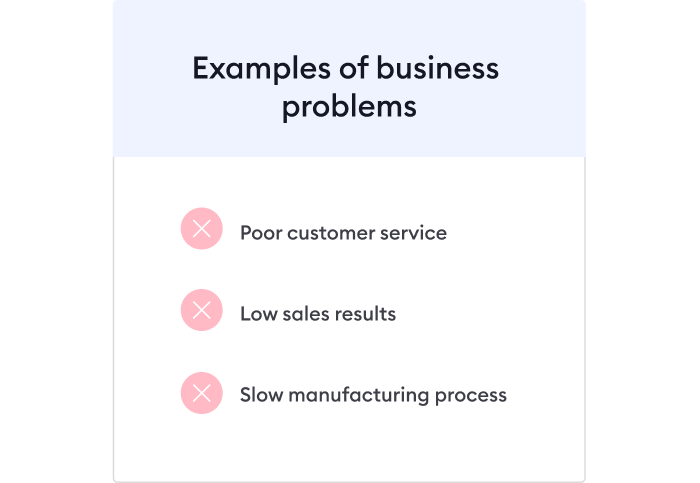
Step 2: Write a SMART Objective
A training goal or objective confirms the reason for learning and communicates the focus of the module. For the best results, think SMART and create a goal that is:
- Specific – the learner knows what they will learn or be able to do after finishing the training course;
- Measurable – learners will leverage this knowledge consistently for each report;
- Achievable – the learner will be able to perform the tasks you expect them to;
- Relevant – the content will be focused on job essential knowledge and skills;
- Timely – the learner will be able to complete it in a timely manner.
A SMART goal will motivate the employee by showing them “what’s in it for me” in learning.
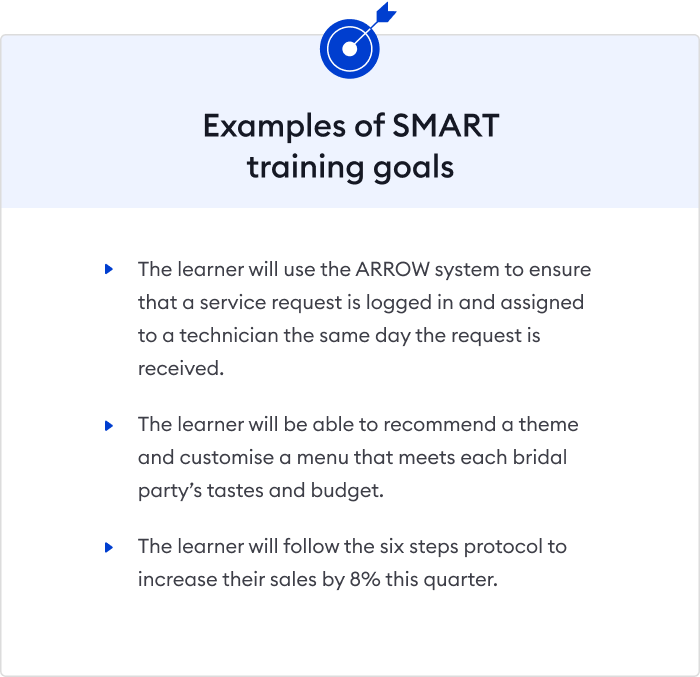
Step 3: Decide on the Right Content Format
After you explore the problem and decide on your objective, you’re all set for the practical part!
The secret to building great training is to match the right kind of training module to the learning task at hand. The chart below aligns different content formats with particular learning needs.
Whether you’ve never worked with any eLearning tool before or you’re an eLeaning pro looking to expand your repertoire and make courses quicker, iSpring Suite will help you create awesome training. It’s able to create varied formats of interactive learning content easily, in the PowerPoint interface and even from existing ppt, Word, and pdf files.
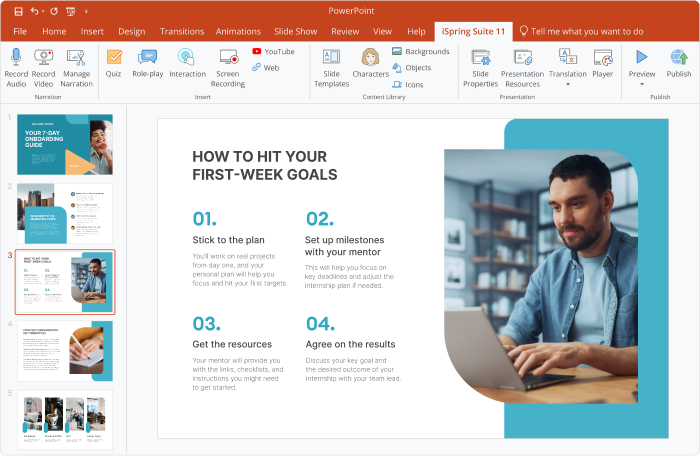
iSpring Suite provides the near-limitless options to populate your slide-based course with quizzes, ready-made interactions, and characters, build role-plays by simply pasting script lines when needed, and record any type of instructional videos without high-tech video editing tools. Plus, it allows you to co-create and review eLearning content together with colleagues in real time, which is great for our next step.
Step 4: Feedback and Revision
After a bit of work on your part, the first version of your training module is ready! Now, it’s time to forward your first draft to your Subject Matter Experts (SMEs) and Stakeholders for feedback and approval.
Don’t be surprised if subject matter experts leave a LOT of feedback on your initial efforts and want to put it all into the training module. This may cause an endless feedback loop which you can successfully prevent with a three-step design protocol, known as alpha/beta/gold:
- The first draft of a training module is known as the alpha draft. For an experienced instructional designer, an alpha draft should be about 75-80% correct. This is typically where you will get the most feedback from your SMEs.
- The revised second version of a training module is the beta draft. If you’ve received quality feedback during the first round, your beta version should be about 95-98% accurate. So, you should have far fewer revisions at this point.
- The final draft is called the gold version. Unless your SMEs have missed vital information in the previous rounds of review, the gold version should be 99-100% correct. SME and Stakeholder review of the gold draft should happen quickly, and now you have awesome training content that’s ready for learners.
Step 5: Run a Pilot with a Test Audience
As a best practice, you should run a pilot of any new training before putting it into circulation across your organization. To get started, select a test audience that consists of a small group of employees who are not proficient in the given topic. Then gather feedback from them and find out what worked best, and what could be improved. If the intended performance goals are not achieved, think of the gaps that might exist. Discuss the ways how to fill in these gaps with SMEs and stakeholders.
Step 6: Create a Final Version, Upload, and Launch
At this stage, you’re ready to create the “final final” version of your training module and upload it to the learning management system (LMS). You may want to work with your business partners, change management, or project management to coordinate a formal roll-out of the new learning initiative.
You may also want to provide detailed reporting data about learning consumption and results 30, 60, and 90 days after your program launches. Tracking data for o n-the-job performance metric s is a great way to show the training’s impact on employee development and actual work performance.
Also read :
→ The 11 Best HR Tools for Streamlining Your Workflow in 2023
→ 17 Key Recruiting Metrics and How to Improve Them with Online Training
Create interactive online courses like a pro
Master every stage of interactive course development with 20 video lessons. Apply theory to practice with expert instructional designers.

FAQ on Training Modules
What is the purpose of training module.
The purpose of training modules is to provide information and instruction on a specific topic or skill. It aims to educate and train individuals to improve their knowledge, skills, or performance in a particular area. The learning module may include various interactive elements, assessments, and resources to enhance the learning experience.
What are the components of a training module?
A training module typically consists of several components, including:
- Introduction: This section provides an overview of the training module and sets the context for the learning objectives.
- Learning Objectives: The module should clearly state what participants will be able to do or understand after completing the training.
- Content: This is the main body of the module, where the actual training material is presented. It may include text, images, videos, interactive elements, and other multimedia resources.
- Activities and Exercises: To enhance learning, modules often include activities and exercises that allow participants to apply the knowledge and skills they have learned.
- Assessments: These are used to measure participant’s understanding and retention of the material. Assessments can take various forms, such as quizzes, tests, or practical assignments.
- Summaries and Reviews: At the end of each section or module, a summary or review section is often included to reinforce key concepts and provide a quick recap of the material covered.
- Resources and References: Additional resources, references, and recommended readings may be provided to further support learning and provide participants with supplementary materials.
- Conclusion: Training module should conclude by summarizing the key points and reiterating the learning objectives.
- Feedback and Evaluation: Participants should have the opportunity to provide feedback on the module and evaluate their learning experience.
- Certificates or Badges: Some training modules may offer certificates or badges upon successful completion, serving as evidence of the participant’s achievement.
Overall, these components work together to create a comprehensive and effective training module.
What is the difference between training module and training manual?
Training modules are designed to deliver information and instruction through a combination of multimedia elements such as videos, audio clips, interactive activities, and quizzes. They often utilize e-learning platforms or software to provide an engaging and interactive learning experience. Training modules are particularly effective in scenarios where hands-on practice, simulations, or demonstrations are required.
On the other hand, training manuals are typically in a written format, consisting of detailed text-based explanations, diagrams, charts, and examples. They provide a comprehensive and systematic overview of the training content, allowing learners to study and reference the material at their own pace. Training manuals are commonly used in self-paced learning environments, where learners can read and review the information independently.
Ultimately, the choice between a training module and a training manual depends on the specific learning objectives, target audience, and available resources. Both formats can be valuable tools for delivering effective training, and often a combination of both may be used to cater to different learning preferences and needs.
Takeaways on Creating a Training Module
- Solve the right business problem!
- Adhere to SMART objectives.
- Try different styles in online learning.
- Use an authoring tool such as iSpring Suite to create engaging learning materials, and an LMS to manage training.
- Bear in mind SME participation, feedback, and revision.
- “Test drive” this new initiative before making it available organization wide.
Training is never a one-and-done experience. Organizations always starve for improvement, so the shelf life of even the best eLearning can be anywhere from a few months to just over a year. Review all of your training modules at least twice a year for accuracy; expect that you will need to either update or completely revise your training modules on an annual basis.
Still don’t have iSpring Suite Max? Download this course authoring software for free now and start creating engaging training modules right away!
If you’re looking for a reliable, easy-to-use LMS, get an iSpring Learn trial or request a demo!
Fast course authoring toolkit
Create online courses and assessments in record time.

Content creator:
Helen Colman
She enjoys combining in-depth research with expert knowledge of the industry. If you have eLearning insights that you’d like to share, please get in touch .
You might also like this

Subscribe to our blog
Stay tuned to get our latest eLearning tips and tricks!
By clicking “Subscribe”, you agree to our Privacy Policy . All emails include an unsubscribe link, so that you can opt-out at any time.
We use cookies to give you the best possible experience on our website and also for analytics and marketing purposes. You can enable or disable optional cookies as desired. See our Cookie Policy for more details.
Manage your cookies
Essential cookies are always on. You can turn off other cookies if you wish.
Essential cookies
Analytics cookies
Social media cookies
Online Business Plan Training Course

Over 120,000 people have so far taken this online tutorial and developed successful business plans to start their new venture.
There is no charge for taking and completing our training modules. The course takes you through our proven planning framework and includes a useful planning template to realise your ideas.
The Composition of the Tutorials
The training is structured into seven easy to follow lessons. Each lesson deals with a particular topic area required in a business plan.
The first lesson comes with a Microsoft Word document that’s pre-formatted for you to fill in the blanks from the knowledge you gain from this tutorial. Here are the course modules:
Why Should You Write a Plan at All?
Most companies or individuals only begin to think about business plan when someone asks them to complete such a document. Usually it’s a bank to apply for a start-up loan or another lender for working capital. But, there are good reasons as to why everyone should have at least a path to where they’re heading.
Various research studies show that:
- More companies stay profitable for longer.
- The owners of the business understand the tactical plans to achieve their longer-term objectives.
- Non-financial and non-marketing people should begin to have an improved understanding of these critical areas of the company.
- You’ll be able to communicate your ideas to others in a structured manner.
Additionally, you’ll have a plan to track progress against and see what’s working and what elements need adjusting to achieve your financial goals.
Preparation and Data Gathering
Check the initial data you need in this business plan preparation guide and fill in the knowledge gaps. Most research and supporting information should be readily available from your own or third-party sources. You’ll see what’s required, where to obtain it, and tips on accessing hard-to-find research.
How to Market Your Business
You’ll learn how to send important communication and promotional messages to new and existing customers to improve buying patterns. Implementing a marketing strategy correctly ensures your business stays ahead of your competitors.
Accounting For All Costs
Managing your expenses in the initial phases of a startup venture is essential to maximise profits. You’ll see all the types of costs and expenses you need to account for in your financial forecasts.
Securing Forms of Business Finance
Most entrepreneurs develop their plans to obtain a method of funding. This lesson details what’s available and how to access investment for new and existing businesses. See how to raise £100,000 for your business venture now!
Attaining Your Planning Goals
The above modules help develop a solid business plan. You can check out additional resources so you don’t need to start from a blank sheet of paper. Start with this proven business planning structure and begin completing each section.
Who Benefits from the Training?
Whatever your goals are in life, this tutorial can help you attain them.
It’s developed so anyone including professionals and non-financial entrepreneurs can partake and quickly understand all the concepts. Among the groups of people who have taken this course are:
- People looking at starting a new business that needs loan finance.
- Those who require venture capital investment.
- Existing businesses looking to expand into new markets.
- Students of business studies courses at all levels.
Begin the Course Today
The course operates exclusively online, and you can get started right away.
Please contact us if you have any questions, comments or ways to enhance this service.
Template library
- Business plan course
- Structure of a plan
- Preparing a plan
- The executive summary
- Cash flow calculator
- SWOT analysis
- Business glossary
- Marketing template
- Sales template
FAO elearning Academy

Course 3: Business plan – Detailed description
Certified course.
Topic outline
This is the third in a series of three e-courses designed to assist field technicians in working with communities, groups or individuals wishing to prepare effective investment proposals. This course explores how to convert a business concept into a detailed business plan with the RuralInvest software and interpret the main indicators.

People with the following profiles would benefit from taking this course:
- Field technicians and extension agents
- Financial institution agents
- International development staff
- Members of universities and training centres
- Business plan development consultants and financial specialists
You will learn about
- Create a business plan with the RuralInvest software from a business concept
- Describe and interpret the two main financial indicators of a business plan: the Internal rate of return (IRR) and the Net present value (NPV)
- Describe long and short term financing options and its related concepts
- Describe how to conduct an incremental and sensitivity analysis
- Configure the software as well as share plans with collaborators
Course structure
The course consists of four lessons, ranging from approximately 20 to 60 minutes duration each:
- Lesson 1 – Business plan – Basic concepts and purpose
- Lesson 2 – Creating a Business plan with the software
- Lesson 3 – Additional analysis: Incremental and Sensitivity analysis
- Lesson 4 – Configuration and administrative functions
System requirements
The online version of this course runs on the latest versions of the major browsers, such as Google Chrome, Microsoft Edge, Mozilla Firefox and Apple Safari.
The downloadable version only runs on Windows PC’s and no additional software is needed.
Digital certification
This course offers certification. You will get your digital badge upon passing a final exam after completing the course and achieving a grade of at least 75%. Please click on the button below to complete the exam, or refer to our Certification section to learn more.
Evaluate this course
We would be pleased to receive your evaluation of this course, to support us in improving future e-learning courses. Please click on the button below to answer the questions in the form. It should only take you a few minutes!
RuralInvest software
The RuralInvest methodology makes use of a software to develop professional business concepts and plans. You can download the RIV software here .


How do I place an order with your paper writing service?
Getting an essay writing help in less than 60 seconds.

IMAGES
VIDEO
COMMENTS
In summary, here are 10 of our most popular business plan courses. Create a business mind map with Coggle: Coursera Project Network. Launch Your Online Business: The State University of New York. Create a Business proposal with Visme for businesses: Coursera Project Network. Entrepreneurship: University of Pennsylvania.
Strategic planning: Delve into strategic thinking and planning covering topics such as setting goals and objectives, creating action plans, and assessing risks and opportunities. Business planning courses can also teach you valuable skills including critical thinking, communication, and research skills that you can apply to your professional life.
THIS COMPLETE BUSINESS PLAN COURSE teaches you everything you need to know in order to make an incredible business plan, including an easy and fun to use 13 STEP program: STEP 1 of 13: General Business Plan Inputs Questions and Analysis. STEP 2 of 13: Creating Your Cover Page: Input Questions, Analysis and Outputs.
Get your business off the ground and secure funding by learning how to write a comprehensive business plan. This free online course will familiarize you with the process of developing business plans. For new businesses, funding is a key factor and this course will help you decide what funding options will be best for your venture. Finally, you ...
Top companies choose Udemy Business to build in-demand career skills. Learn the best business planning tools and techniques from top-rated Udemy instructors. Whether you're interested in new business plan templates, organizing a management team, or presenting your business vision, Udemy has a course to help you develop as a business manager.
Step 3: Create your training module template. Once you know what content you'll use, it's time to put it into a template. You can build one from scratch or save time and effort by choosing a premade one. If you're using an LMS for training, you should be able to easily plug in content and get up and running quickly.
The course introduces a pragmatic and process-based approach to developing and implementing business plans. The course offers participants the tools to transform ideas into strategic goals and to outline the operational and financial strategies needed to achieve these goals. The course expands on how to use the business plan as a communication ...
Tuesday 6:30PM - 9:30PM PT. Future Offering (Opens April 29, 2024 12:00:00 AM) See Details. 397618. Fee: $855.00. In Person. Location: UCLA Extension Gayley Center in Westwood.
Enrol onto the Business Planning program at home or on campus at one of our 46 career colleges in Canada. Learn at your own pace with Academy of Learning. 1-855-978-3988
Describe Your Services or Products. The business plan should have a section that explains the services or products that you're offering. This is the part where you can also describe how they fit ...
Create a Brief Business Plan. Fill out a canvas of your choosing for a well-known startup: Uber, Netflix, Dropbox, Etsy, Airbnb, Bird/Lime, Warby Parker, or any of the companies featured throughout this chapter or one of your choice. Then create a brief business plan for that business.
MODULE 8 - DEVELOPMENT OF A BUSINESS PLAN 6 9. Funding requirements 10. Appendices Please note: Contrary to the Modules 1 to 7, this Module does not contain exercises. The exercise for you is to write your own Business Plan, and if you have done it well, then it will soon become your own (and confidential!) good practice example!
Upon completing this 'Complete Business Plan Writing and Development Training Course' successfully, participants will be able to: Understand the steps and different formats of business plan writing. Design and construct a detailed written business plan. Write your business plan that contains the most effective business strategies.
Types of training modules. How to develop training modules. Step 1: Define the problem. Step 2: Write a SMART objective. Step 3: Create the right type of training module. Step 4: Collect feedback and revise. Step 5: Run a pilot training module with a test audience. Step 6: Create a final version, upload, and launch.
Here is a basic template that any business can use when developing its business plan: Section 1: Executive Summary. Present the company's mission. Describe the company's product and/or service offerings. Give a summary of the target market and its demographics.
training. In Module 2 you undertook a feasibility study, it is time to proceed to the preparation of the business plan. The feasibility studies answer the question "will this work". A business plan answers the ques-tion "how will this work". This module focuses on the preparation of a basic business plan aimed at
The training is structured into seven easy to follow lessons. Each lesson deals with a particular topic area required in a business plan. The first lesson comes with a Microsoft Word document that's pre-formatted for you to fill in the blanks from the knowledge you gain from this tutorial. Here are the course modules:
This is the third in a series of three e-courses designed to assist field technicians in working with communities, groups or individuals wishing to prepare effective investment proposals. This course explores how to convert a business concept into a detailed business plan with the RuralInvest software and interpret the main indicators. People with the following profiles would benefit from ...
on whether your training program is designed for internal or external training . This guide provides helpful insights to create a training plan that will help you increase the efficiency and effectiveness of your training program . We'll provide insights for how to: • Develop a comprehensive training program plan • Identify goals and ...
ONLINE COURSE/MODULE PROJECT PLANNING Business Plan Development for Online Learning This is a project planning guide for teams developing online learning environments. All of the ... Development Strategies for Online Volunteer Training Modules: A Team Approach. Journal of Extension [On-line], 52(1), Article 1FEA6. 2
This is a manual for how to conduct a business training program for Maasai micro entrepreneurs, providing basic skills needed for starting up or improving a micro business. The training program has been developed in the Olkiramatian group ranch in the Rift Valley in Kenya, based on field research and test train-ings.
Business Plan Training Module. We select our writers from various domains of academics and constantly focus on enhancing their skills for our writing essay services. All of them have had expertise in this academic world for more than 5 years now and hold significantly higher degrees of education. Once the writers get your topic in hand, only ...